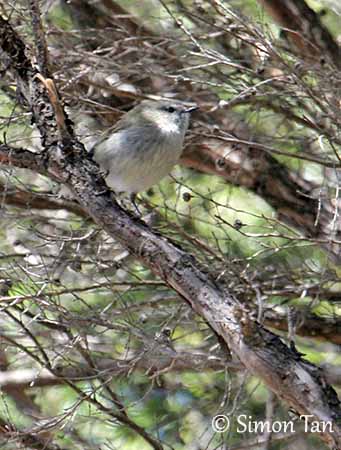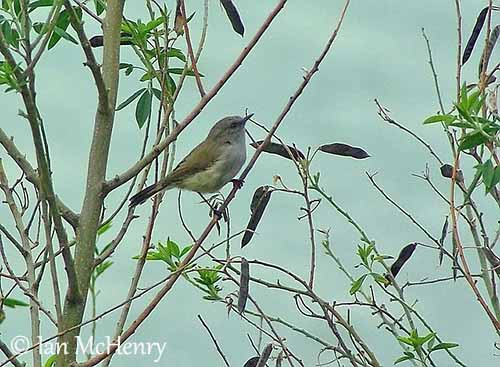
Fr: Gérygone de Nouvelle Zélande
Ang: Grey Gerygone – Grey Warbler
Maori: Riroriro
All: Maorigerygone
Esp: Gerigón Maorí
Ita: Gerigone grigia della Nuova Zelanda
Nd: Maorimangrovezanger
Sd: Grå gerygone
Photographers:
John Anderson
John Anderson Photo Galleries
Ken Havard
My Bird Gallery & Flickr gallery 1 & Flickr gallery 2
Ian McHenry
My New Zealand Birds
Simon Tan
PBase Bird galleries
Text by Nicole Bouglouan
Sources:
HANDBOOK OF THE BIRDS OF THE WORLD Vol 12 by Josep del Hoyo-Andrew Elliott-David Christie - Lynx Edicions - ISBN: 8496553423
KNOW YOUR NEW ZEALAND BIRDS by Lynnette Moon - New Holland Publishers – ISBN: 1869660897
BirdLife International (BirdLife International)
New Zealand bird status between 2008 and 2012
New Zealand birds and birding (Narena Olliver)
Wikipedia, the free encyclopaedia
Tiritiri Matangi Open Sanctuary
Home page
Page Passeriformes Order
Grey Gerygone or Grey Warbler
Gerygone igata
Passeriformes Order – Acanthizidae Family
INTRODUCTION:
The Grey Gerygone is endemic to New Zealand where it is widespread. More often heard than seen, it occurs in most habitats from sea to alpine levels in forested and wooded areas. Its Maori name is “Riroriro”.
DESCRIPTION OF THE BIRD:
Biometrics:
Length: 10-11 cm
Poids: 5,5-6,5 g
The adult is a tiny grey songbird. The upperparts are greyish-olive. The tail shows a broad, blackish subterminal band, and there are white spots near the tips of all rectrices except the central feathers.
On the underparts, chin, throat and breast are grey, whereas the rest of underparts is white. There is sometimes a pale yellow or grey wash on flanks.
The face is grey. The bill is black and finely pointed. The eyes are red. Legs and feet are black.
Both sexes are similar.
The juvenile shows paler face and breast, and pale eyering.

RANGE:
The Grey Gerygone is present on both North and South Islands, Stewart Island and adjacent offshore islands.
HABITAT:
The Grey Gerygone frequents all areas wherever there are trees or shrubs. It is found in forest, scrub, mangrove and thicket, from mid to high level of canopy. For this reason, this species is difficult to observe.
CALLS AND SONGS: SOUNDS BY XENO-CANTO
The Grey Gerygone male sings for territorial purposes, from perch or in flight. The song is sweet and heard throughout the seasons. We can hear high-pitched trills and tremulous warbles often abruptly interrupted and repeated later.
During displays, chases and copulation, it gives a harsh chatter. When threatened, the bird produces quiet bill-clicking. The contact call is a short “chip”.
BEHAVIOUR IN THE WILD:
The Grey Gerygone is an insect eater and feeds on caterpillars, flies, beetles, moths and various other invertebrates. It also takes spiders.
It forages on tree trunks and branches, hovering sometimes in mid-air outside the canopy, and plucking insects from leaves and outer branches.
It may also eat ripe fruits and seeds.
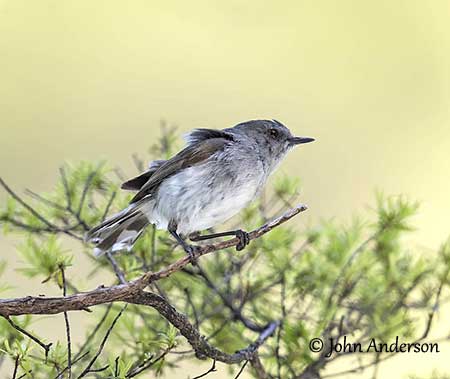
The Grey Gerygone forages alone or in pairs, sometimes in small group of less than ten birds. Outside the breeding season, it can be seen with mixed-species flocks including Mohouidae species, Tomtits, New Zealand Fantail and some others, including introduced species such as Common Chaffinch.
The pair stays all year round in its territory, but this area is defended only during the breeding season by the male which sings frequently. They are monogamous and solitary nesters. The mates stay together year after year.
The Grey Gerygone is mostly resident, only performing some local movements. Altitudinal migration is reported on the East coast of South Island, and maybe in other areas according to the cold weather. This species is vagrant in Snares islands.
It usually flies short distances. When foraging, it moves among the canopy, almost hovering with fast wingbeats while gleaning preys from outer foliage.
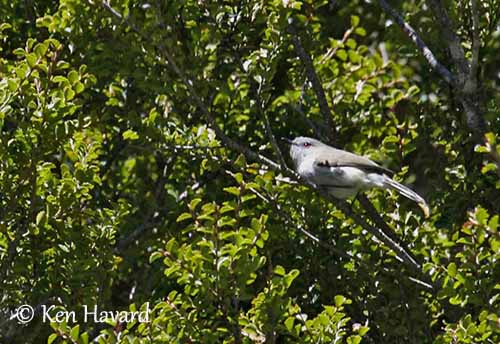
REPRODUCTION OF THIS SPECIES:
The Grey Gerygone breeds between August and January, sometimes from July to February. The breeding season starts later on South Island and Stewart Island, usually in September.
The pair collects nest materials such as rootlets and grass stems which are woven together with moss, fur, ferns and bark. Spider webs are added to bind the materials together. The inner part is lined with feathers and plant down.
This pear-shaped nest has a side entrance towards the top, with a vegetal hood to protect it. This structure is suspended from a branch and can be attached at other points too. Such nest may sometimes have a dangling “tail”.
The nest-site is usually in thickets of manuka (Leptospermum scoparium), or small-leafed trees like kahikatea (Dacrycarpus dacrydioides), with the nest placed in tree, shrub or vines.
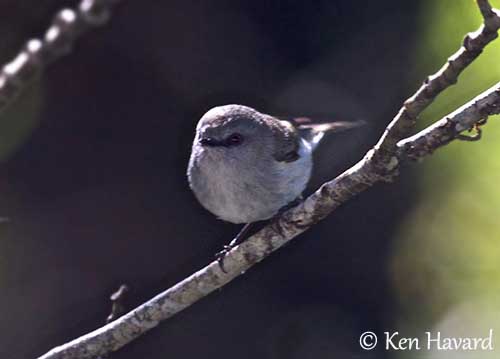
The female lays 3-4 white to pale pink eggs with darker spots. She incubates during 17-21 days and broods the chicks during the first days. They are fed by both parents and fledge 15-19 days after hatching. They still depend on adults for up to 35 days after leaving the nest. The male care them while the female starts a second brood.
The Grey Gerygone is the usual host of the Shining Cuckoo.
PROTECTION / THREATS / STATUS:
The Grey Gerygone is locally abundant in suitable habitat throughout the range. It has adapted to human modification of the landscapes, and is usually common in both rural and urban habitats.
This species is not currently threatened and evaluated as Least Concern.
